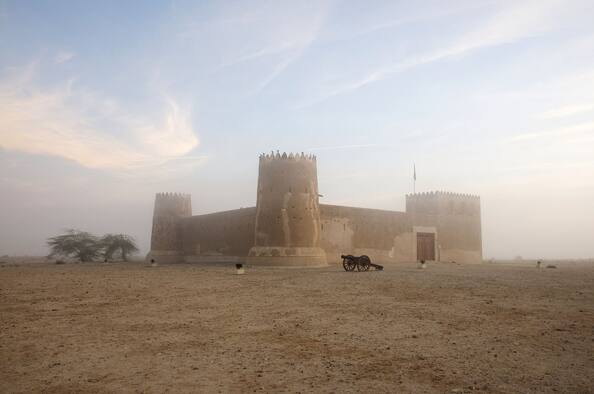Sitio arqueológico de Al Zubarah
Al Zubarah Archaeological Site
The walled coastal town of Al Zubarah in the Persian Gulf flourished as a pearling and trading centre in the late 18th century and early 19th centuries, before it was destroyed in 1811 and abandoned in the early 1900s. Founded by merchants from Kuwait, Al Zubarah had trading links across the Indian Ocean, Arabia and Western Asia. A layer of sand blown from the desert has protected the remains of the site’s palaces, mosques, streets, courtyard houses, and fishermen’s huts; its harbour and double defensive walls, a canal, walls, and cemeteries. Excavation has only taken place over a small part of the site, which offers an outstanding testimony to an urban trading and pearl-diving tradition which sustained the region’s major coastal towns and led to the development of small independent states that flourished outside the control of the Ottoman, European, and Persian empires and eventually led to the emergence of modern day Gulf States.
Description is available under license CC-BY-SA IGO 3.0
Site archéologique d’Al Zubarah
La ville côtière fortifiée d’Al Zubarah, sur le golfe persique, est devenue un centre florissant de pêche et de commerce des perles au 18e et au début du 19e siècle, avant d’être détruite et abandonnée en 1811. Créée par des marchands du Koweït, Al Zubarah entretenait des liens commerciaux avec l’océan Indien, l’Arabie et l’Asie occidentale. Une couche de sable du désert a protégé les vestiges de palais, de mosquées, de souks, de maisons à patios, du port et de ses murs de défense, d’un canal, de murs de protection et de cimetières, ainsi que de huttes de pêcheurs. Seule une petite partie du site a été fouillée. Il témoigne de façon remarquable de la tradition perlière et commerçante qui a fait vivre les villes côtières du golfe persique, amenant le développement de petits Etats indépendants qui ont prospéré indépendamment de la domination des empires ottoman, européen et perse, et qui sont les ancêtres des actuels Etats du golfe.
Description is available under license CC-BY-SA IGO 3.0
Sitio arqueológico de Al Zubarah
source: UNESCO/CPE
Description is available under license CC-BY-SA IGO 3.0
アル・ズバラ考古遺跡
真珠産業で発展した港町の遺構。ドーハ北方のアル・ズバラは、クウェート商人が建設した、城壁に囲まれた港町。18世紀後半以降、インド洋と西アジアとを結ぶ真珠産業と交易で栄えたが、1811年に破壊され、20世紀には放棄された。いまだ宮殿やモスク、街路、中庭住宅、漁師小屋、墓地などが砂に埋もれているが、一部の遺跡は発掘されており、都市交易と真珠採りの伝統を物語る。アル・ズバラの発展は、オスマン帝国やヨーロッパ、ペルシャなどの大国の支配によらずに周辺の主要都市を育み、小さな独立国の発展を促した点で、きわめて価値が高い。source: NFUAJ
Archeologisch gebied Al Zubarah
De ommuurde kustplaats Al Zubarah in de Arabische Golf werd gesticht door kooplieden uit Koeweit. In de laat 18e en begin 19e eeuw bloeide ze uit tot centrum van handel en de parelindustrie. De handelsconnecties strekten zich uit over de Indische Oceaan, Arabië en West-Azië. Al Zubarah werd in 1811 verwoest en begin 1900 verlaten. Een laag woestijnzand heeft de overblijfselen van paleizen, moskeeën, straten, huizen en vissershutten beschermd. Daarnaast resteren de haven, dubbele verdedigingsmuren, een gracht en begraafplaatsen. De opgravingen getuigen van stedelijke handel en parelduiken; activiteiten die de grote regionale kuststeden ondersteunden en uiteindelijk hebben geleid tot de opkomst van de huidige Golfstaten.
Source: unesco.nl
